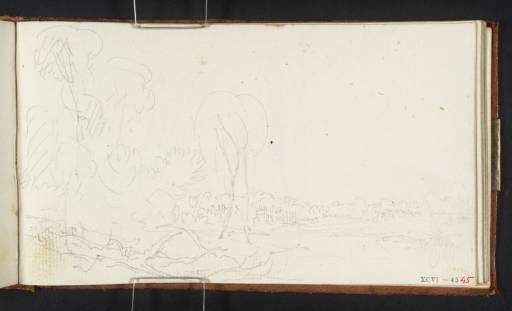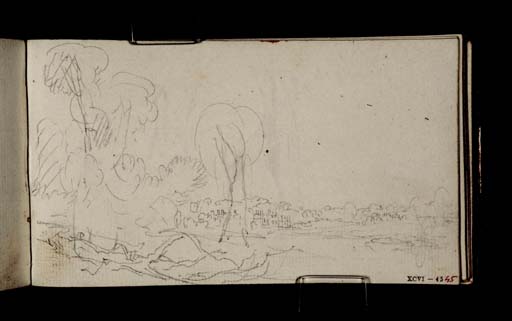Joseph Mallord William Turner Pope's Villa at Twickenham 1807
Image 1 of 2
Joseph Mallord William Turner,
Pope's Villa at Twickenham
1807
Joseph Mallord William Turner 1775–1851
Folio 45 Recto:
Pope’s Villa at Twickenham 1807
D06015
Turner Bequest XCVI 45
Turner Bequest XCVI 45
Pencil on white laid paper, 92 x 163 mm
Inscribed by John Ruskin in red ink ‘45’ bottom right
Stamped in black ‘XCVI 45’ bottom right
Inscribed by John Ruskin in red ink ‘45’ bottom right
Stamped in black ‘XCVI 45’ bottom right
Accepted by the nation as part of the Turner Bequest 1856
Exhibition history
1990
Painting and Poetry: Turner’s ‘Verse Book’ and his Work of 1804–1812, Tate Gallery, London, June–September 1990 (32).
References
1909
A.J. Finberg, A Complete Inventory of the Drawings of the Turner Bequest, London 1909, vol.I, p.249, XCVI 45, as ‘Landscape, with fallen tree in foreground’.
1990
Andrew Wilton and Rosalind Mallord Turner, Painting and Poetry: Turner’s ‘Verse Book’ and his Work of 1804–1812, exhibition catalogue, Tate Gallery, London 1990, pp.128, 129.
The Twickenham house of the poet Alexander Pope, remodelled as a villa by James Gibbs in 1720 and surrounded by gardens designed by the poet himself, was demolished in 1807 on the orders of Baroness Howe, who built another house nearby. She left only its most famous feature, the grotto in the basement of the villa, and stripped the grounds. Turner was distressed by such vandalism against the memory of a poet so strongly associated with the Thames-side landscape and one who had influenced his own literary efforts. As a Pastoral poet he even likened Pope to Virgil, calling him the ‘British Maro’.1
Here, from a position down-river, Turner has drawn the house partly dismantled but still showing traces of the wings added by Sir William Stanhope in the 1750s. The sketch served as the basis for his commemorative picture, Pope’s Villa at Twickenham, During its Dilapidation, shown at his own gallery in 1808 (on the London art market, 2008).2 Turner set up an impromptu studio in the summer-house of his Hammersmith house, and perhaps Pope’s Villa was painted there as the sketchbook was in use during visits. Butlin and Joll do not mention this drawing as its source, but quote the account of the 1808 exhibition in the Review of Publications of Art, possibly by John Landseer, stating that the view is ‘from the Middlesex bank of the river, or perhaps (as we conjecture) from one of the Twickenham aits: probably that which lies off the grounds of Strawberry Hill’.3
A fallen tree in the foreground of this drawing also appears in the painting, where it symbolises the weeping willow – one of the first to be imported into England – planted by Pope but later blown down in a storm as if as a portent of the destruction to come. When, subsequently, John Britton composed commentary for the engraving of the picture by John Pye and Charles Heath for his anthology Fine Arts of the English School, and chose to identify the willow as the one planted by the poet, Turner reined him in; ‘making the willow tree the identical Pope’s willow is rather strained – cannot you do it by allusion?’.4 Thus corrected, Britton’s published letterpress stated only that ‘in strict accordance with the subject, is the prostrate trunk of a willow tree’.
Besides painting his picture from this sketch, Turner also wrote his own verses on the demolition of the villa, not least in this sketchbook itself, folios 68–76 (D06053–D06070) and back cover (D406534).5 They include a still-sketchy but graphic passage:
Hark the rude hammer
Harsh steel the sawn rafter Breaks
Down from the roof the massy give way
Rent the wall, and let in the day
Harsh steel the sawn rafter Breaks
Down from the roof the massy give way
Rent the wall, and let in the day
David Blayney Brown
October 2008
How to cite
David Blayney Brown, ‘Pope’s Villa at Twickenham 1807 by Joseph Mallord William Turner’, catalogue entry, October 2008, in David Blayney Brown (ed.), J.M.W. Turner: Sketchbooks, Drawings and Watercolours, Tate Research Publication, December 2012, https://www


